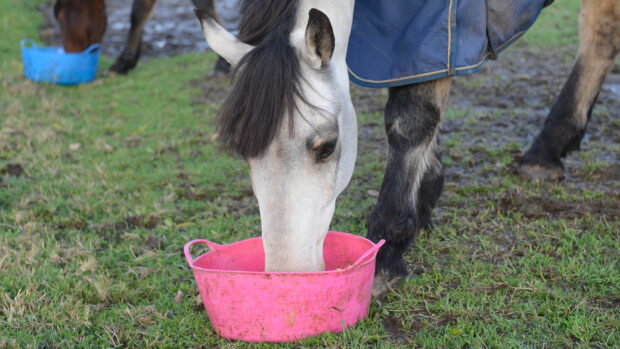The amount of feed a horse eats is fundamental to his overall well-being, while the way the energy is supplied can make the difference between riding a well-mannered horse and one which is bursting out of his skin.
Every feed, except water, contains energy. The lowest energy feedstuff is straw and the highest is oil. Most of the horse’s energy comes from carbohydrates in the form of fibre, starch and sugar, while oil and protein contribute less energy as they make up less of the diet.
Slow-release carbohydrates
The majority of energy is supplied to the horses from fibre, which is often dismissed as being just roughage in the forms of hay and straw. In fact, all forage is a complex mixture of carbohydrates, which are digested through fermentation in the hindgut.
Certain types of fibre are digested at different rates, providing a constant low-level energy release into the bloodstream. This steady release reduces the likelihood of energy “boosts” leading to unmanageable behaviour.
Feeding large amounts of low-energy forage such as hay will not provide enough energy for sustained work but many feed companies have developed fibre-based feedstuffs that offer higher levels of energy in a slow-release format.
Fast-release carbohydrates
Starch and sugar are rapidly broken down in the small intestine and absorbed into the blood stream as simple sugars. In comparison to fibre, these provide “fast energy” and are available soon after a meal, which can lead to bad behaviour in excitable horses.
In addition, the horse has a limited capacity for digesting starch and sugar, which can result in undigested material finding its way into the hindgut. Because the microbes are not capable of handling starch, this can make the horse become uncomfortable and fractious.
Starch and sugar are not all bad, however. Some starch is necessary to keep the muscles functioning and sugar is essential for the brain and nervous system.
Oil
Oil is easily digested and absorbed in the small intestine, but its use as a muscle fuel is slower than starch or sugar, and this is why it has a reputation for being a good slow-release energy source.
Oil is energy rich – it contains three-times the energy of oats, which means not much is needed to replace or supplement hard feed. This is good because there are practical problems associated with feeding it in any quantity.
Protein
A horse does not generally use protein as fuel, but when excess levels of protein are present in the diet it can be broken down in the liver and used as energy or stored as fat.
|
This feature was part of Horse & Hound’s feed special (10 October 2002). Would you like to have Horse & Hound delivered to your door every week but pay less than if you bought it at the newsagents? Click here to find out how. |



